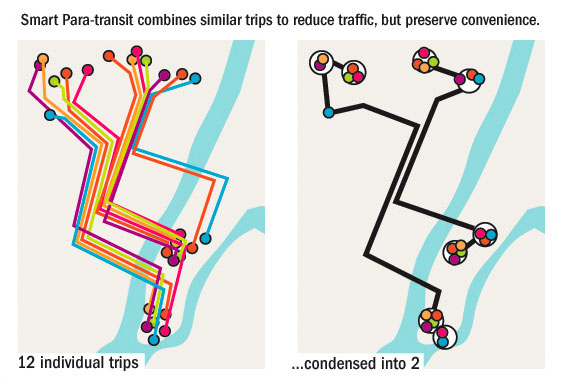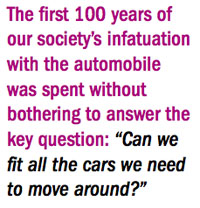Peer-to-Peer Mass Transit: How to Make it Work
Here is the second installment of Streetsblog publisher and LimeWire founder Mark Gorton’s essay, "Smart Para-Transit: A New Vision for Urban Transportation." Part 1 is here and you can also download the complete pamphlet.

Advances in information and communications technology offer
the possibility of optimizing the performance of our existing road network in
ways that were not possible even ten years ago. The ubiquity of web-enabled cell phones has put a mobile data input device into the hands of the vast majority of citizens. By applying cell phone, internet, and computer technologies, New York now has the opportunity to create a system
which can vastly speed travel times, increase the throughput of our road
network, carry more people, while at the same time, radically reducing the
number of vehicles on the road, gasoline usage, CO2 emissions, congestion,
traffic, and the harm that traffic inflicts on our neighborhoods.
A new form of mass transit can be created that offers trip
times highly competitive with the private automobile to nearly all points in
the region. This new form of mass
transit takes advantage of the existing road network and requires very little
in the way of capital investment. This
new form of transit is Smart Para-Transit.
Background
 The past 100 years have seen New York City and the rest of
The past 100 years have seen New York City and the rest of
the country spend huge amounts of money on road infrastructure improvements to
serve automobiles. With the advantage of
hindsight, neglecting investment in mass transit while promoting automobile
usage may have been a poor policy decision; however, highways, bridges,
tunnels, and roads have been built, and New York must now maximize the value it
receives from the hundreds of billions of dollars spent on its surface
transportation infrastructure.
Although cars have been a significant presence in our world
for as long as anyone can remember, from a historical perspective, the
automobile is still a relatively new invention. The first 100 years of our society’s infatuation with the automobile was spent without bothering to answer the key question: "Can we fit all the cars we
need to move around?" Congestion and traffic jams are a way of life in New York. The previous answer to congestion was to build more roads, bridges, and tunnels; however, the added road capacity only encouraged more driving and led to even more congestion. Our society now
knows that it is impossible to build its way out of its congestion problems.
In a city where space is very dear, the private car is the
least spatially efficient form of transportation in use. However, for all of its drawbacks, the car is
still an amazing technology. When the
roads are not congested and parking is available, it offers faster trip times
than any other means of travel.
New York City is blessed with a fine mass transit system
that provides good transit options to most of the people in the region. However, for outlying parts of the New York
City region, the transit options are a poor substitute for the mobility
provided by the private car.
How Smart Para-Transit
Would Work
Smart Para-Transit uses information technology to group and
optimize the existing trips that take place on the road network. Smart Para-Transit has a number of
components. The physical transport
component is a large fleet of dynamically routed vehicles: small vans, large
vans, small buses, and large buses. As
opposed to typical mass transit today, these vehicles would not run on
predetermined routes. Instead, a central
computer collects information about requested trips, figures out how best to
group passengers, and dynamically dispatches vehicles to service the required
trips.
In a city as dense as New York, lots of people make highly
similar trips at the same time using private cars. Smart Para-Transit allows for grouping of
these similar trips to reduce the wasteful overlap that occurs with many
individual cars traveling the same routes. Take for example the group of people who want to travel from Tribeca to
Montclair, NJ around 5:30 PM on a Tuesday. There might be a dozen people who plan to make this trip by car in a 15
minute period. These dozen people might
require 8 separate cars for their trips. Instead of 8 separate cars, one large van could fit 12 people and
consolidate these 8 vehicles into just one vehicle. The van could make 3 quick stops in Tribeca,
pick up all 12 people and head directly to Montclair. Once in Montclair, the van could stop at a
couple of central transit points, and then continue directly to some passengers
houses.
The vans need not be beat up vehicles that we typically
associate with van services today. They
could be environmentally friendly hybrids with plush interiors with cup holders
and ports to plug in computers.
Here is how Smart Para-Transit might look from a user point
of view. Before beginning a trip, a
user would enter their current location, their destination, and their desired
departure time into the system. The
Smart Para-Transit system could be accessed via website, mobile phone, or
traditional phone. The centralized computer
would take this trip information and direct the user to a pick a point within a
few blocks of their current locations. The user would then walk to this pick up point. Within a few minutes a bus or van would stop
at the pickup point and load the riders. The bus or van would then head directly to the destination area and
disburse the passengers at a handful of points. The trip would be nearly as direct as a car trip and would involve no
transfers and minimum waiting.
Examples of para-transit are in operation today. Super Shuttle runs a fleet of blue vans to
airports. The Hampton Jitney bunches
trips for people heading out the beach, and MTA operates Access-A-Ride for people
whose disabilities prevent them from being about to use traditional buses and
subways. All of these services are much
more limited, and less technologically sophisticated than the Smart
Para-Transit system that could be built, but they each show elements of the
larger potential system.





